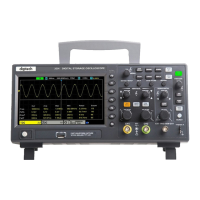User Manual
51
/
76
Run/Stop the pass/fail function.
Select the signal input channel.
Use the Multifunctional Knob to set a horizontal tolerance range:
0.020div-4.00div.
Use the Multifunctional Knob to set a vertical tolerance range:
0.025div-8.00div.
Create a rule template according to the two setups above.
Select a save position for the rule.
1-10 locations for internal flash memory.
Recall the waved rule setups.
Turn on or off the display of the number of failed passes.
Run or stop the pass/fail test.
Enter STOP state if output exist or continue to run if output exists.
Pass/Fail
Pass Ring/Fail Ring
Output a negative pulse train when the test is passed; Output a negative pulse
train when the test is failed.
Same as pass failure mode, accompanied by ringing.
2.15. Fast Action Buttons
Auto Set: Automatically set the oscilloscope controls to generate a usable display of the input signals. Refer to the following
table for relative content.
Single: Acquire a single waveform and then stop the acquisition.
Run/Stop: Continuously acquire waveform or stop the acquisition.
Default Setup: automatically recall the default settings.
Help: Press to enter the built-in help system, press any other key to view the corresponding help information, and press this
key again to exit the help system.
Save To USB: Save the current screen image to a USB external storage device.
Decode: Display protocol decoding, set the main parameters of decoding. For details, see 2.8 Protocol Decoding.
Time/Div: Press the time base knob to enter the dual window display mode. Press the knob again to exit the dual window
display.
2.15.1. AUTO SCALE
Auto Scale is one of the advantages digital oscilloscopes have. When you push the Auto Scale button, the oscilloscope will
identify the type of waveform (sine or square wave) and adjust controls according to input signals so that it can accurately
display the waveform of the input signal.

